By Jeffrey A. Rendall, Photos By Jeffrey A. Rendall
KENSINGTON, MD -- There are many different paths to fame. Some folks get there by being in the right place at the right time; others work silently their entire careers, only to get noticed and honored when it's too late to enjoy the recognition; and still others achieve lasting notoriety through a predominance of good work over the course of decades. Their names are out there for people to see, and if they're good enough, it'll be a pleasant association.
This latter group certainly includes golf architect Tom Clark, of Ault, Clark & Associates, located in Kensington, Maryland. Along with partners Brian and Eric Ault and Daniel Schlegel (and associates), the firm has confidently entrenched itself as the Mid-Atlantic region's most prevalent and recognizable golf architectural entity, having a hand in hundreds of golf course designs and renovations in the region.
Clark joined Ed Ault, the firm's founder, in 1971, and since that time has established quite a name and reputation for being a 'hands on' architect, who enjoys being involved in all facets of course construction. Clark helped design the Washington DC region's annual PGA Tour venue, TPC Avenel, and has worked closely with professional playing consultant Curtis Strange on a number of other notable layouts, such as the Woods Course at Kingsmill and the redesign of Bide-A-Wee in Portsmouth. He's also served as President of the American Society of Golf Course Architects (ASGCA, in 1991). Not too shabby for a boy from the outskirts of Philly.
Though it's probably not as well known, Clark qualifies as a gifted storyteller. I've had the pleasure of speaking with him on several of his projects (also with Brian and Eric Ault), and he's always more than willing to vividly describe the tales behind each golf course. He's got an incredible memory for detail, and it's clear he puts his heart and soul into each piece of 'art' he designs. Here, he presents some thoughts on his career, including some philosophies and thoughts on how technology is impacting the game today:
Q: Being familiar with golf in the Mid Atlantic, it's obvious your firm's work is represented in just about every corner of the region. You've certainly got quite a few courses in communities. Is there a story behind that?
Clark: We've been involved in hundreds of projects -- not just in this area, but all over the country and world as well. And yes, we've done a good share of golf communities. We've probably designed more golf courses for communities than anyone else in the United States.
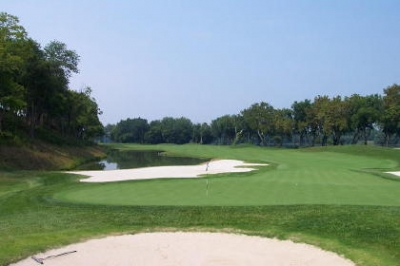 |
| Clark designed River Creek Club, which sits adjacent to the Potomac River near Leesburg. The finishing holes are unbelivable. |
I've done about 70, Mr. Ault did 150 and Brian -- there's one developer he's built 25 golf courses for alone. It's a trend in real estate development these days -- developers know golf courses bring in people to buy houses, and the overall benefits of having a course near you are many. One of ours, River Creek, was the fastest growing development on the east coast for three years in a row.
But with land becoming so expensive, residential requirements are also getting more restrictive. We're always trying to get our backyard corridors up to 400 feet (as opposed to 300 feet in width). A lot of developers don't want to give up the space. But having more room certainly enhances the golf experience, as well as protects the residents from the somewhat unpleasant part of owning a home on a golf course -- being pelted with stray golf balls.
Q: What's your general philosophy when designing golf courses?
Clark: I don't know if it's a 'philosophy' as much as it's adapting to what the owner has in mind (daily fee, private club, residential course), and the type of market in the course's location. Taking Pleasant Valley (in Chantilly) as an example, the owner wanted it to be the flagship for public golf in the area (Fairfax County). So basically we were able to include all the things we like to incorporate into a golf course at that site.
Those 'things' being returning nines, the correct orientation of the starting and finishing holes so you're not starting and then finishing into the sun. It involves a good mix of par fours of all different lengths -- some being close to drivable, and some that are pretty long from the back tees. We might want to include a couple reachable par fives, and one or two that aren't; a good mix of par threes facing different directions; some dogleg left holes, dogleg right holes; varying challenges from the different sets of tees. Real solid golf variety, that's what we're after.
We also want to create something visually special with every course we design.
Q: In your experience, what makes golf fun for the average player?
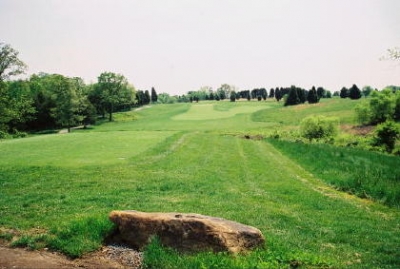 |
| The 4th hole at Pleasant Valley is one of Clark's favorites on the course. He must like long and challenging par threes. |
Clark: That's really getting back into philosophies, but my feeling is basically -- our whole objective in designing golf courses is to ensure the person remembers the course, remembers the holes and wants to come back. And hopefully what he or she takes away from the experience is a pleasant day and a pleasant round.
What's fun? One of the biggest things I've learned over the years is to try and reach the point where the player doesn't lose a ball. For speed of play, and everything else, that's a huge consideration. We want to get it so he can hit it and find it, and keep moving. That helps everyone come away with smiles on their faces.
You try not to put in any demand carries for the average player, or if there is one, to provide for a 'safe' option to go around it -- so you don't have to go over water or wetlands... you may not be shooting directly at the pin, but you can always get around the trouble without losing a ball.
That's part of the problem we're faced with today -- with ever increasing restrictions on construction. We have four or five courses on our drawing boards that are just covered with wetlands and areas we won't be able to touch, and that just makes it so difficult for the average player, or higher handicapper, even with the tee options we give them. It makes it tough for them not to lose golf balls -- and when they do lose one, they're not happy.
That unhappiness shows up on the course's bottom line, too. When you've got players going out and losing every ball they brought along, they're probably not going to go back. In that situation, the course really isn't a good product, not a good golf course, and people know that.
We do everything we can to avoid that problem, believe me.
Q: Has the evolution in equipment technology impacted the way you map out courses?
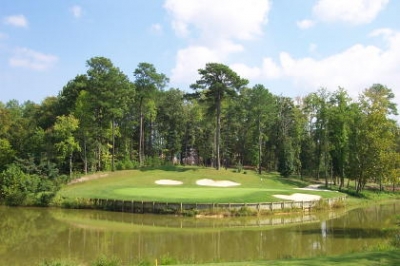 |
| You'll need to fly it to the 9th hole at Cypress Creek -- and there's no possible to get there by land. |
Clark: That's something we as architects are very cognizant of. It's gotten to the point that if something doesn't happen in the industry (USGA Standards), we'll soon be designing 8,000-yard golf courses.
Our courses now, quite honestly -- most of our championship yardages are over 7300 yards. And we had gotten back to where a 6800 or 6900 yard course could be a great course, but no longer. It's obsolete, at least at the highest playing levels.
Q: But is it the equipment as much as it is better players?
Clark: Certainly some credit goes to guys working out and working on their games, but in my mind, there's no question it's the equipment that's responsible for most of it.
At our ASGCA conference a couple years ago, we had representatives from the USGA as well as manufacturers, and they admitted they could make the ball as much as 15% longer and the clubs as much as 20% longer -- and still keep it within the guidelines of the USGA. That's pretty scary.
It doesn't necessarily affect the average golfer as much as the touring professional, who's got the right swing and clubhead speed. He's the one who really benefits. Look at some of the drives these days -- 320, 330, 340 for averages -- it's getting ridiculous. You're seeing clubs going back and lengthening their tees year after year. Look at Augusta National -- they're always making changes, looking for more length out of that golf course.
We absolutely think about these things when designing courses. We consider the width of fairways, how far out the bunkers have gotten. We like to make a lot of our bunkers visual -- you know, targets. And now they've got to be 290 yards out, whereas 250 yards used to be the norm. It's incredible how things have changed.
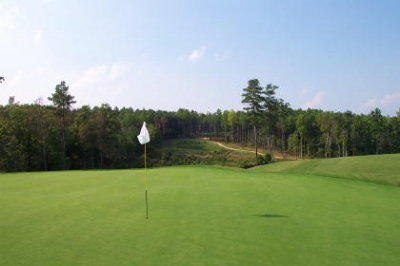 |
| Brickshire's ups and downs will allow you to use all the length your advanced equipment will provide. Here, the par three 14th. |
Q: Would you say designing a walkable course is important?
Clark: Well, I guess having grown up walking golf courses, and realizing the ambiance of what that's all about, it's pretty important. But having done so many golf course communities where you have to take a cart -- getting the chance to design a walking friendly course is a pleasant change. And I think many people have gotten away from that.
Q: Golf course design in this region is complicated by a lot more than environmental restrictions -- there's an awful lot of history to be concerned with. Any examples stick out in your mind?
Clark: Absolutely! The Woods Course at Kingsmill is a perfect example. There we had to go through phase one, phase two and phase three archeological studies on about three golf holes. It basically forced us to reroute several of the holes -- that's why we have two very short ones on the front side.
I doubt many people know how expensive it is to go through a phase three dig -- that's where they literally sift the dirt, and sit around for six days at a time. It's incredible to watch them -- how meticulous it all is. You've got to be a special kind of person to do that, I guess.
So the work went on and on. That was one of the nice things about working with Curtis Strange on that project, because he lives down there and could get very involved with it. Whenever he was home, he'd go check things out and give me a call. He spent a lot of time out there, and by and large we'd have scheduled visits when we'd walk around together -- he had a lot of input into the design.
Q: Any other Strange stories at the Woods Course?
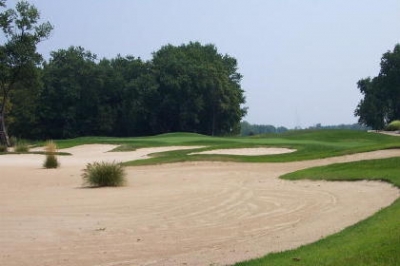 |
| River Creek's 17th hole features a huge waste bunker. River Creek is fairly walkable, like a nice private club should be. |
Clark: Sure. The sixteenth hole is a risk-reward par five with a prominent tree that guards a dogleg. All throughout the layout, we'd leave trees here and there that I thought were adding to the course. Well, of course Curtis wanted 'em knocked down -- so it got to be kind of a joke -- we started calling them 'Curtis's Trees.'
From an architectural standpoint, he was making some sound suggestions -- because whenever you plan a hole around a tree, it's probably going to die (laughs). Then, of course, one of the big ones did.
Q: What else have you learned from working with professional playing consultants?
Clark: Working with Ed Sneed at TPC Avenel was a good experience. He opened our eyes to a lot of things PGA Tour players really enjoy about a course. Like the incorporation of a short par four -- that's #14. We also put in the short fifth hole, where you don't have to use driver.
Ever since that time, we've incorporated a short hole on each one of our nines. I just love those holes, and the public loves 'em too. They're holes where you can go for the green and possibly putt for an eagle, or be a bit off and make a double.
Sneed also reiterated how much players hate not being able to see a hazard. The things that tour players don't like are generally the same things average players don't like.
Q: One thing I've noticed over the years -- that measured yardages aren't always consistent. What's the procedure for making sure everything's correct?
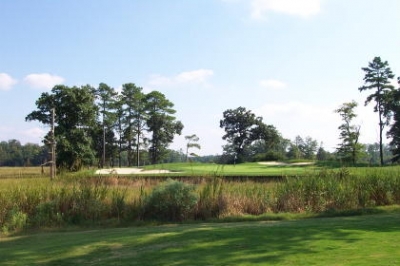 |
| Cypress Creek was the first project that Clark and Curtis Strange teamed up on. It's very beautiful, and not well known. |
Clark: Good question. We do our own scorecards. We go out with our laser binoculars and measure from point to point. We use 800 feet to our landing area from the back tee. We take two steps off the back tee, then all the other measurements we put from the middle of the tees. We shoot to the landing area, then from the landing area to the center of the green.
For par fives, we shoot to the first landing area, then go to a second landing area about 200 yards from there, then to the green from that point.
A lot of the rating committees will go directly at the green for that second shot, and I don't know why they do that, because it may be over water or wetlands, with no way to get there in two. So sometimes par fives end up shorter than I think they should be.
You have to look at each individual club -- they all do it differently. But as far as the rating committees, they do it a little differently than we do.
Q: That might explain why a course like Cypress Creek has a slope rating of 130 from the back tees (despite several wetlands carries), and Brickshire has a slope of 144 (and is wide open, for the most part) -- is that right?
Clark: That is rather unusual. I've never quite understood how they figure some of those things out. We cleared Brickshire to be extra wide, and it still got a rating of 144. At Cypress Creek, there are some lengthy demand carries on 15, 16 & 17, and you can sure lose a ball in a hurry there. I'm not sure how to explain it.
The rating mystery is probably one of only a few things Clark can't explain, at least when it comes to the golf business. He seems to know just about everyone involved, and there's no question he's well versed in how to construct a course.
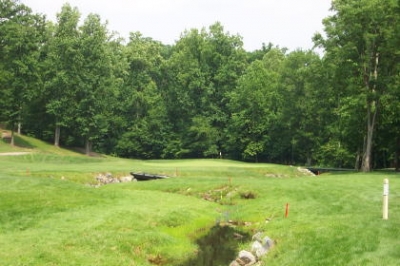 |
| The 12th hole at TPC Avenel is consistently one of the toughest on the PGA Tour, year after year. 472 yards long, and a difficult green, too. |
I told him he should come and build a putting green in my front yard, and he told me for my purposes, I'd be better off going with one of those synthetic putting surfaces -- for costs involved, maintenance, and durability. Who can doubt he knows from experience.
There's no question he'd make the same honest assessments for anyone who might throw a query his way. He's a straight shooter, and a storehouse of knowledge. It's no wonder his firm's work is found in just about every front and backyard in the Mid Atlantic.
Details:
For more information on Clark or Ault, Clark & Associates, I suggest you access their Website: Ault, Clark & Associates. Or, you might try the American Society of Golf Course Architects' Website, ASGCA Site.
| Related Links | Comments on this article? | |
|
Maryland National Golf Club Hollow Creek Golf Club Rocky Gap Resort PB Dye Golf Club in Ijamsville Whiskey Creek Golf Club |
E-mail Jeff Rendall, Editor: jrendall@golftheunitedstates.com |











